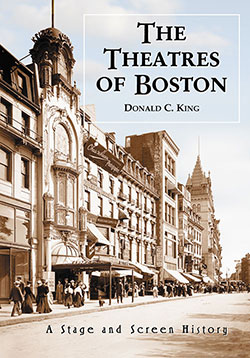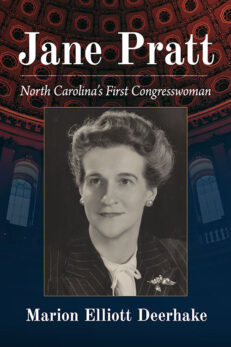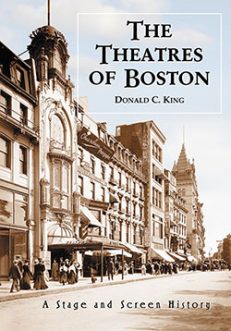The Theatres of Boston
A Stage and Screen History
$49.95
In stock
About the Book
The theatre had a difficult time establishing itself in Massachusetts. Colonial authorities in Boston were adamantly opposed to theatrical amusements of any kind. In the mid-eighteenth century, even theatricals performed in the homes of private citizens aroused the indignant ire of puritanically minded authorities. In 1750 the General Court of Massachusetts passed an act prohibiting stage plays or any other theatrical entertainment. In 1762, the New Hampshire House of Representatives refused a theatre troupe admission to the town of Portsmouth on the ground that plays had a “peculiar influence on the minds of young people and greatly endangered their morals by giving them a taste for intriguing amusement and pleasure.” The first public dramatic performance in Boston was produced at a coffeehouse on State Street by two English actors and some local volunteers. In 1775 General John Burgoyne, himself an actor and playwright, converted Boston’s Faneuil Hall into a theatre, where he presented, among other pieces, The Blockade of Boston. After the Revolutionary War, in February 1794, the dramatic history of Boston may be said to have begun with the opening of the Boston Theatre.
The history of Boston theatres from the eighteenth century through the present is covered in this well illustrated work. Although the theatre had a somewhat rocky beginning, by 1841 more than 15 theatre houses—including the Boston Theatre, Concert Hall, Merchants Hall, Boylston Hall, the Washington Gardens Amphitheatre, the Tremont Theatre, the Washington Theatre, the American Amphitheatre, the Federal Street Theatre, Mr. Saubert’s Theatre, the Lion Theatre, the National Theatre (which boasted gas lighting), and the Howard Athenaeum—were all established. After these first theatres paved the way and puritanical restraint had been overcome, the public’s enthusiasm for varied entertainment prevailed and theatres proliferated in the city. This book details the long and storied history of Boston theatre construction, alteration, restoration, and, in many cases, destruction. Information is also provided about building architecture, types of performances, ticket prices and other interesting data about each theatre’s history.
About the Author(s)
Bibliographic Details
Donald C. King
Format: softcover (7 x 10)
Pages: 278
Bibliographic Info: 117 photos, appendices, notes, bibliography, index
Copyright Date: 2008 [2005]
pISBN: 978-0-7864-3874-7
Imprint: McFarland
Table of Contents
Acknowledgments v
Preface 1
Chapter 1 (1750–1776) 5
God Bless the British
Chapter 2 (1791–1794) 10
Foiling the Bluenoses, Lecture Halls, Rooms and Museums
Chapter 3 (1794–1841) 15
The First Theatres
Battle of the Managers
The Lion and the Lamb
Chapter 4 (1841–1843) 28
Exit Tremont Theatre, Enter Tremont Temple
The Rise of the Boston Museum
Chapter 5 (1843–1846) 31
The End of the World
Enter the Howard Athenaeum
The Boston Museum Moves up Tremont Street
Chapter 6 (1847–1852) 37
Exit the First Boston Theatre
The Adelphi and New National Theatres
Chapter 7 (1852–1857) 43
Ancestors of the Movie Palaces
The Boston Music Hall and the Second Boston Theatre
Chapter 8 (1857–1861) 51
The Great Financial Panic of 1857
The Prince of Wales Comes to Boston
Chapter 9 (1861–1873) 55
Minstrels, Aquariums and a New Boston Museum
The Second Tremont Theatre and the Selwyn
Chapter 10 (1874–1879) 63
Abbey and Schoeffel Meet John Stetson Head-On
The Park Theatre Is Built in Fifty Days
Chapter 11 (1879–1882) 67
The First “Movies” and Summer Theatres
The Boston Bijou and Thomas Alva Edison
Chapter 12 (1883–1885) 86
Benjamin Franklin Keith Comes to Boston
Battle of the Museums
The Hollis Street Theatre
Chapter 13 (1885–1889) 92
The Year of the “Mikados” and the Grand Opera House
George E. Lothrop’s Lady Natators
Colonel Austin and Alexander Graham Bell
Chapter 14 (1889) 95
Improvements at the Boston Theatre
The Third Tremont Theatre
Chapter 15 (1889–1891) 97
B.F. Keith Invents Vaudeville
Enter Edward Franklin Albee
Chapter 16 (1892–1894) 103
The Bowdoin Square Theatre
B.F. Keith Builds a Palace
Chapter 17 (1894–1896) 116
Cyclorama to Castle Square Theatre
The End of an Era
Chapter 18 (1896–1897) 127
The Motion Picture Comes to Boston
Keith Builds a Subway
Burlesque at the Palace and the Old Howard
Chapter 19 (1898–1899) 133
The Last Days of the Boston Museum
European Music Halls in Boston
Chapter 20 (1900) 135
B.F. Keith and the Vaudeville Wars
The United Booking Office
William Morris and the Boston Music Hall
Chapter 21 (1900–1903) 137
The Colonial, Majestic, and Globe Theatres
The Brothers Shubert Arrive
Chapter 22 (1905–1908) 144
The Music Hall Becomes Loew’s Orpheum
A Sleeping Giant Wakes Up
The Poor Man’s Amusement
Chapter 23 (1908–1910) 151
The Gaiety Theatre, the Boston Opera House
The Sam S. Shubert Theatre
Chapter 24 (1911–1912) 157
The National and the Plymouth Theatres
Tremont Temple Becomes a Movie Palace
Gordon’s Olympia and Saint James
The First Feature Length Films
Chapter 25 (1912–1915) 164
Famous Players in Famous Films,
in Famous Theatres: Enter Adolph Zukor
Chapter 26 (1915–1924) 171
Boston’s First Movie Palace
Loew’s Braves Field
The Shuberts Build a Subway and the Copley Turns Around
Chapter 27 (1925–1927) 178
The Third Boston Theatre
The Mighty Metropolitan
The Mystery House
Chapter 28 (1926–1929) 188
“Auld Lang Syne” at B.F. Keith’s Theatre
The Voice of the Screen
The B.F. Keith Memorial Theatre
Chapter 29 (1929–1937) 197
Albee Out, Kennedy In, RKO Is Born
The Shuberts in Receivership
The Great Depression and Proven Pictures
Memories of the Scollay Square Palace
Chapter 30 (1938–1949) 208
U.S. Sues Paramount Pictures over Monopoly
Walt Disney’s Fantasia Saves the Majestic
The Coconut Grove Tragedy, Bye Bye Bijou
Chapter 31 (1950–1958) 214
U.S. Sues Shubert over Monopoly
3-D, CinemaScope, and Cinerama
Ben Sack Steps In and the Boston Opera House Steps Out
Chapter 32 (1958–1979) 221
The Old Howard’s Swan Song
Ben Sack Takes Over the Met and
Keith’s Pornography Comes to Washington Street
Sarah Caldwell Gets Her Opera House
Chapter 33 (1979–2002) 231
Lose Some, Save Some
Bringing Back Boston’s Downtown
Memories of the Bijou
Appendix 1: Boston Theatres in Chronological Order 237
Appendix 2: How Patrons Got to Boston Theatres 248
Chapter Notes 255
Bibliography 259
Index 261





